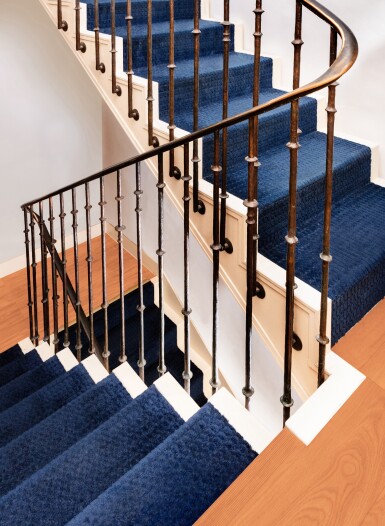Important Design
Important Design

Diego Giacometti
Unique banister rail, special commission
Live auction begins on:
May 20, 12:30 PM GMT
Estimate
250,000 - 350,000 EUR
Lot Details
Description
Diego Giacometti
Unique banister rail, special commission
1981
Patinated bronze and patinated steel
Composed of 41 bars, including 6 forming balustrades
Approximate overall length: 629 cm ; 247 ⅝ in.
Height of straight-cut bars (6): 106.5 cm ; 41 ⅞ in.
Height of bias-cut bars (35): 111 cm ; 43 ¾ in.
Approximate depth: 12 cm ; 4 ¾ in.
Comissionned directly from the artist by the present owner in 1981
Private collection, Paris
For related examples :
Daniel Marchesseau, Diego Giacometti, Paris, 1986, p. 76-78 and p. 114-115
Daniel Marchesseau, Diego Giacometti, Paris, 2005, p. 76-79 and p. 114-115
Daniel Marchesseau, Diego Giacometti, sculpteur de meubles, Paris, 2018, p. 210-213
With Diego Giacometti, the staircase goes far beyond its function as a simple means of circulation. In fact, it's the staircase that structures the space and inscribes its movement into the architecture. Furthermore, when created by an artist, it becomes a works of art in its own right. Railings, handrails, rungs: each line can draw a rhythm, embody a gesture, suggest a story. The artist has explored this dimension in a number of commissions, giving the staircase a poetic and sculptural charge. As early as the 1960s, he was designing bare banisters charged with profound sensitivity. With him, furniture - and banisters in particular - became a natural extension of sculpture.
Diego Giacometti created his first banister for Marguerite and Aimé Maeght's Saint-Paul-de-Vence farmhouse. Several others followed, installed for Parisian duplexes including the Palais-Royal, Quai des Célestins, Quai de Béthune and several houses in Switzerland. But it was the one designed for Michel and his wife Hélène Bokanowski that made the greatest impression on our client. However, it would be more than five years before Diego finally agreed to create his own.
Over time, the man tends towards a gradual stripping away of animal figures. This banister, designed in 1981, embodies this ultimate phase in the expression of his art: pure, sober lines, driven above all by the power of gesture. This minimalism is a quest for precision, where every irregularity, every variation in material, bears the trace of the manual shaping of this sculptor who readily repeated “that he was first and foremost a craftsman.” For him, the handrail is designed for the hand, it must be sensual, and its shape dictates that it embraces the body and accompany movement. Thereby, everything hinges on a subtle balance, as the great artist explained when he said, “the important thing is to have a sense of proportion”. Not too high, not too low, not too thin, not too massive. It is in this fragile alchemy that the silent beauty of Diego Giacometti's work lies.
Far from ostentation, our banister embodies an intimate vision of art: that of an everyday object elevated to the rank of sculpture, where use, elegance and poetry find their meeting point.
© ADAGP, Paris, 2025
You May Also Like










